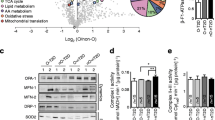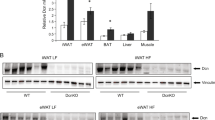Abstract
Aims/hypothesis
Increased extracellular matrix (ECM) collagen is a characteristic of muscle insulin resistance. Matrix metalloproteinase (MMP) 9 is a primary enzyme that degrades collagen IV (ColIV). As a component of the basement membrane, ColIV plays a key role in ECM remodelling. We tested the hypotheses that genetic deletion of MMP9 in mice increases muscle ColIV, induces insulin resistance in lean mice and worsens diet-induced muscle insulin resistance.
Methods
Wild-type (Mmp9 +/+) and Mmp9-null (Mmp9 −/−) mice were chow or high-fat (HF) fed for 16 weeks. Insulin action was measured by the hyperinsulinaemic–euglycaemic clamp in conscious weight-matched surgically catheterised mice.
Results
Mmp9 −/− and HF feeding independently increased muscle ColIV. ColIV in HF-fed Mmp9 −/− mice was further increased. Mmp9 −/− did not affect fasting insulin or glucose in chow- or HF-fed mice. The glucose infusion rate (GIR), endogenous glucose appearance (EndoRa) and glucose disappearance (Rd) rates, and a muscle glucose metabolic index (Rg), were the same in chow-fed Mmp9 +/+ and Mmp9 −/− mice. In contrast, HF-fed Mmp9 −/− mice had decreased GIR, insulin-stimulated increase in Rd and muscle Rg. Insulin-stimulated suppression of EndoRa, however, remained the same in HF-fed Mmp9 −/− and Mmp9 +/+ mice. Decreased muscle Rg in HF-fed Mmp9 −/− was associated with decreased muscle capillaries.
Conclusions/interpretation
Despite increased muscle ColIV, genetic deletion of MMP9 does not induce insulin resistance in lean mice. In contrast, this deletion results in a more profound state of insulin resistance, specifically in the skeletal muscle of HF-fed mice. These results highlight the importance of ECM remodelling in determining muscle insulin resistance in the presence of HF diet.







Similar content being viewed by others
Abbreviations
- [14C]2DG:
-
2-Deoxy[14C]glucose
- ColIV:
-
Collagen IV
- ECM:
-
Extracellular matrix
- EndoRa:
-
Endogenous glucose appearance rate
- GIR:
-
Glucose infusion rate
- HF:
-
High-fat
- ICv :
-
Hyperinsulinaemic–euglycaemic clamp
- MMP:
-
Matrix metalloproteinase
- Ra:
-
Glucose appearance rate
- Rd:
-
Glucose disappearance rate
- Rg:
-
Glucose metabolic index
- SVL:
-
Superficial vastus lateralis
- VEGF:
-
Vascular endothelial growth factor
- vWF:
-
von Willebrand factor
References
Richardson DK, Kashyap S, Bajaj M et al (2005) Lipid infusion decreases the expression of nuclear encoded mitochondrial genes and increases the expression of extracellular matrix genes in human skeletal muscle. J Biol Chem 280:10290–10297
Berria R, Wang L, Richardson DK et al (2006) Increased collagen content in insulin-resistant skeletal muscle. Am J Physiol Endocrinol Metab 290:E560–E565
Kang L, Ayala JE, Lee-Young RS et al (2011) Diet-induced muscle insulin resistance is associated with extracellular matrix remodeling and interaction with integrin alpha2beta1 in mice. Diabetes 60:416–426
Kang L, Lantier L, Kennedy A et al (2013) Hyaluronan accumulates with high fat feeding and contributes to insulin resistance. Diabetes 62:1888–1896
Thrailkill KM, Clay Bunn R, Fowlkes JL (2009) Matrix metalloproteinases: their potential role in the pathogenesis of diabetic nephropathy. Endocrine 35:1–10
Brinckerhoff CE, Matrisian LM (2002) Matrix metalloproteinases: a tail of a frog that became a prince. Nat Rev Mol Cell Biol 3:207–214
Weber BH, Vogt G, Pruett RC, Stohr H, Felbor U (1994) Mutations in the tissue inhibitor of metalloproteinases-3 (TIMP3) in patients with Sorsby’s fundus dystrophy. Nat Genet 8:352–356
Martignetti JA, Aqeel AA, Sewairi WA et al (2001) Mutation of the matrix metalloproteinase 2 gene (MMP2) causes a multicentric osteolysis and arthritis syndrome. Nat Genet 28:261–265
Peng WJ, Yan JW, Wan YN et al (2012) Matrix Metalloproteinases: a review of their structure and role in systemic sclerosis. J Clin Immunol 32:1409–1414
Nelson AR, Fingleton B, Rothenberg ML, Matrisian LM (2000) Matrix metalloproteinases: biologic activity and clinical implications. J Clin Oncol 18:1135–1149
Derosa G, Ferrari I, D’Angelo A et al (2008) Matrix metalloproteinase-2 and -9 levels in obese patients. Endothelium J Endothelial Cell Res 15:219–224
Signorelli SS, Malaponte G, Libra M et al (2005) Plasma levels and zymographic activities of matrix metalloproteinases 2 and 9 in type II diabetics with peripheral arterial disease. Vasc Med 10:1–6
Tinahones FJ, Coin-Araguez L, Mayas MD et al (2012) Obesity-associated insulin resistance is correlated to adipose tissue vascular endothelial growth factors and metalloproteinase levels. BMC Physiol 12:4
Vu TH, Shipley JM, Bergers G et al (1998) MMP-9/gelatinase B is a key regulator of growth plate angiogenesis and apoptosis of hypertrophic chondrocytes. Cell 93:411–422
Acuff HB, Carter KJ, Fingleton B, Gorden DL, Matrisian LM (2006) Matrix metalloproteinase-9 from bone marrow-derived cells contributes to survival but not growth of tumor cells in the lung microenvironment. Cancer Res 66:259–266
Ducharme A, Frantz S, Aikawa M et al (2000) Targeted deletion of matrix metalloproteinase-9 attenuates left ventricular enlargement and collagen accumulation after experimental myocardial infarction. J Clin Invest 106:55–62
Asahi M, Asahi K, Jung JC, del Zoppo GJ, Fini ME, Lo EH (2000) Role for matrix metalloproteinase 9 after focal cerebral ischemia: effects of gene knockout and enzyme inhibition with BB-94. J Cereb Blood Flow Metab 20:1681–1689
Vermaelen KY, Cataldo D, Tournoy K et al (2003) Matrix metalloproteinase-9-mediated dendritic cell recruitment into the airways is a critical step in a mouse model of asthma. J Immunol 171:1016–1022
Collins S, Martin TL, Surwit RS, Robidoux J (2004) Genetic vulnerability to diet-induced obesity in the C57BL/6J mouse: physiological and molecular characteristics. Physiol Behav 81:243–248
Ayala JE, Bracy DP, McGuinness OP, Wasserman DH (2006) Considerations in the design of hyperinsulinemic-euglycemic clamps in the conscious mouse. Diabetes 55:390–397
James DE, Burleigh KM, Kraegen EW (1986) In vivo glucose metabolism in individual tissues of the rat. Interaction between epinephrine and insulin. J Biol Chem 261:6366–6374
Ayala JE, Bracy DP, Julien BM, Rottman JN, Fueger PT, Wasserman DH (2007) Chronic treatment with sildenafil improves energy balance and insulin action in high fat-fed conscious mice. Diabetes 56:1025–1033
Steele R, Wall JS, de Bodo RC, Altszuler N (1956) Measurement of size and turnover rate of body glucose pool by the isotope dilution method. Am J Physiol 187:15–24
Kraegen EW, James DE, Jenkins AB, Chisholm DJ (1985) Dose-response curves for in vivo insulin sensitivity in individual tissues in rats. Am J Physiol 248:E353–E362
Bonner JS, Lantier L, Hasenour CM, James FD, Bracy DP, Wasserman DH (2013) Muscle-specific vascular endothelial growth factor deletion induces muscle capillary rarefaction creating muscle insulin resistance. Diabetes 62:572–580
Olfert IM, Howlett RA, Tang K et al (2009) Muscle-specific VEGF deficiency greatly reduces exercise endurance in mice. J Physiol 587:1755–1767
Tschop MH, Speakman JR, Arch JR et al (2012) A guide to analysis of mouse energy metabolism. Nat Methods 9:57–63
Kaiyala KJ, Morton GJ, Leroux BG, Ogimoto K, Wisse B, Schwartz MW (2010) Identification of body fat mass as a major determinant of metabolic rate in mice. Diabetes 59:1657–1666
Kaiyala KJ, Schwartz MW (2011) Toward a more complete (and less controversial) understanding of energy expenditure and its role in obesity pathogenesis. Diabetes 60:17–23
Hollborn M, Stathopoulos C, Steffen A, Wiedemann P, Kohen L, Bringmann A (2007) Positive feedback regulation between MMP-9 and VEGF in human RPE cells. Investig Ophthalmol Vis Sci 48:4360–4367
Bergers G, Brekken R, McMahon G et al (2000) Matrix metalloproteinase-9 triggers the angiogenic switch during carcinogenesis. Nat Cell Biol 2:737–744
Pompei LM, Steiner ML, Theodoro TR et al (2013) Effect of estrogen therapy on vascular perlecan and metalloproteinases 2 and 9 in castrated rats. Climacteric J Int Menopause Soc 16:147–153
Surwit RS, Kuhn CM, Cochrane C, McCubbin JA, Feinglos MN (1988) Diet-induced type II diabetes in C57BL/6J mice. Diabetes 37:1163–1167
Lee YS, Li P, Huh JY et al (2011) Inflammation is necessary for long-term but not short-term high-fat diet-induced insulin resistance. Diabetes 60:2474–2483
Sprague AH, Khalil RA (2009) Inflammatory cytokines in vascular dysfunction and vascular disease. Biochem Pharmacol 78:539–552
Amento EP, Ehsani N, Palmer H, Libby P (1991) Cytokines and growth factors positively and negatively regulate interstitial collagen gene expression in human vascular smooth muscle cells. Arterioscler Thromb 11:1223–1230
Galis ZS, Muszynski M, Sukhova GK et al (1994) Cytokine-stimulated human vascular smooth muscle cells synthesize a complement of enzymes required for extracellular matrix digestion. Circ Res 75:181–189
Tooke JE, Goh KL (1998) Endotheliopathy precedes type 2 diabetes. Diabetes Care 21:2047–2049
Tooke J (1999) The association between insulin resistance and endotheliopathy. Diabetes Obes Metab 1(Suppl 1):S17–S22
Pinkney JH, Stehouwer CD, Coppack SW, Yudkin JS (1997) Endothelial dysfunction: cause of the insulin resistance syndrome. Diabetes 46(Suppl 2):S9–S13
Kubota T, Kubota N, Kumagai H et al (2011) Impaired insulin signaling in endothelial cells reduces insulin-induced glucose uptake by skeletal muscle. Cell Metab 13:294–307
Braet F, Wisse E (2012) AFM imaging of fenestrated liver sinusoidal endothelial cells. Micron 43:1252–1258
Cogger VC, McNerney GP, Nyunt T et al (2010) Three-dimensional structured illumination microscopy of liver sinusoidal endothelial cell fenestrations. J Struct Biol 171:382–388
Konstantinopoulos PA, Karamouzis MV, Papatsoris AG, Papavassiliou AG (2008) Matrix metalloproteinase inhibitors as anticancer agents. Int J Biochem Cell Biol 40:1156–1168
Hu J, van den Steen PE, Sang QX, Opdenakker G (2007) Matrix metalloproteinase inhibitors as therapy for inflammatory and vascular diseases. Nat Rev Drug Discov 6:480–498
Acknowledgements
We would like to thank the Vanderbilt Translational Pathology Shared Resource for performing the immunohistochemical staining of ColIV, CD31 and vWF. Part of the data from this study has been orally presented at the American Diabetes Association 72nd Scientific Sessions in 2012 and an abstract was published in ‘Orals’, Diabetes, 2012.
Funding
This work was supported by National Institutes of Health Grants DK054902 (DHW) and DK059637 (Mouse Metabolic Phenotyping Center; DHW). We would also like to thank the Vanderbilt Diabetes Research and Training Center (DK020593).
Contribution statement
LK, was responsible for the experimental design and researched data, contributed to the discussion and wrote the manuscript. WHM, FDJ and DPB researched data and reviewed the manuscript. DHW was responsible for the experimental design, and reviewed data, contributed to the discussion and reviewed/edited the manuscript. All authors approved the final version of this manuscript.
Duality of interest
The authors declare that there is no duality of interest associated with this manuscript.
Author information
Authors and Affiliations
Corresponding author
Electronic supplementary material
Below is the link to the electronic supplementary material.
ESM Table 1
(PDF 401 kb)
ESM Fig. 1
(PDF 90 kb)
Rights and permissions
About this article
Cite this article
Kang, L., Mayes, W.H., James, F.D. et al. Matrix metalloproteinase 9 opposes diet-induced muscle insulin resistance in mice. Diabetologia 57, 603–613 (2014). https://doi.org/10.1007/s00125-013-3128-1
Received:
Accepted:
Published:
Issue Date:
DOI: https://doi.org/10.1007/s00125-013-3128-1




